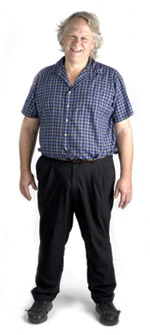Innovator Interview: Stephen Bannasch
 Q. You co-founded the Concord Consortium. What are some things you did prior to that?
Q. You co-founded the Concord Consortium. What are some things you did prior to that?
A. In 1982 I designed a data-logging system with a KIM-1 microcontroller to monitor the performance of an experimental passive solar home I had helped build. The analysis of these data was my thesis project in college and this work led very nicely into my work on probeware with Bob Tinker at TERC.
Q. What was an especially interesting project or moment in CC’s history?
A. In our early days, we held a retreat at a historic barn in Shelburne Farms, Vermont, where we came up with the idea for INTEC*, which was the forerunner of the Virtual High School.
Q. What do you see in the future of educational technology that excites you?
A. Cheaper and more powerful mini-tablet/iPad-like devices. These platforms will help make it possible for students to interact with powerful real-time abstractions in a visual interface (for example, sensor graphs, sensor fusion graphs, and sensor-model interactions) on a portable device. There are many compelling situations to explore in our extended physical environment, and connecting kids to the world around them is meaningful and motivating. Combining the two can produce a wonderful synergy.
Q. You often say that you hope our work will change the world. In what way do you hope the world changes as a result?
A. Many ways. I want more people to become creators and explorers sharing their discoveries. I want to develop ways of authentically assessing science inquiry, analysis, and communication skills, hopefully by extracting this information from portfolios of student work and their collaboration with other students. Unless we have ways of measuring how well we accomplish these goals in this environment of high-stakes assessment, the educational system will continue the current trends, which devalue these skills.
Q. What do you like to do outside of work?
A. Play with my kids. Go sea kayaking with friends. Play music every other Sunday night in the local bar. Go for walks with my dog. Play Frisbee. Go sailing as fast as I can on a Hobie Cat. I once got my hang glider to 13,000 feet. And I spent a week in Italy with a circus traveling by horse-drawn carriage.
Q. Can you describe the projects you’re currently working on?
A. I’m co-PI on the Engineering Energy Efficiency project. We want to find out how the use of simulations might encourage deeper and more effective student learning in solar house design. The project is different than many at CC because more of the student work is open-ended engineering rather than structured inquiry. I’m also co-PI on the VISUAL project where we are working with researchers at the University of California, Berkeley to explore how visualizations?—??including those used in students’ narratives, argumentation, portfolios, and presentations?—?change and hopefully improve science learning. As Director of Technology, I also contribute to many projects, like CLEAR, which is also collaborating with Berkeley to investigate how science assessments can capture and contribute to cumulative, integrated learning in middle school. When we work together on problems like these, what we are doing can make a positive difference in the world.
Q. You referred to making a “positive difference in the world” again.
A. I really believe it!
* The International Netcourse Teacher Enhancement Coalition (INTEC) was one of the first large-scale online teacher professional development courses in the country, offering courses to 800 math and science secondary teachers.
